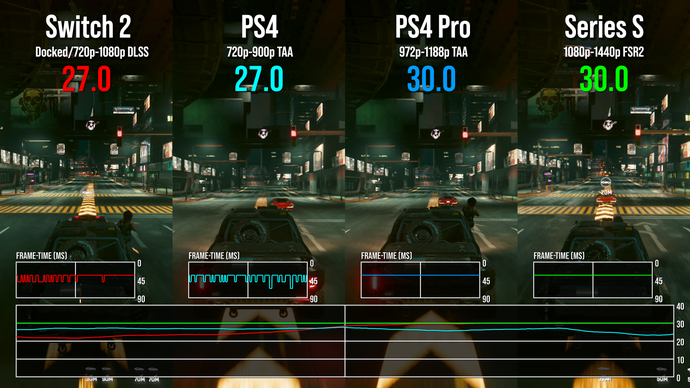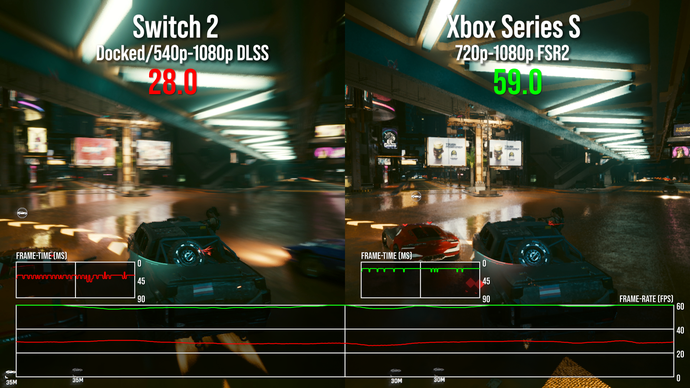During Digital Foundry’s recent Cyberpunk 2077 Switch 2 vs Steam Deck face-off, we used internal benchmarks hidden within the game to compare CPU and GPU performance with some fascinating results – but those test sequences actually run on any version of the game out there. In fact, we’d warrant that they’d even present on the Stadia version if it were still about. Originally, the plan was to dump our PS4 and PS4 Pro data on DF Clips – but we had a re-think in light of a fascinating interview by Wccftech with Virtuos satellite studio Black Shamrock.
It’s rare for a developer to candidly talk about system performance, let alone compare one console directly against another, but comments from Black Shamrock’s Eoin O’Grady were intriguing, kicking off with his thoughts on graphics performance: “GPU-wise, the Switch 2 performs slightly below the Series S; this difference is more noticeable in handheld mode. However, the Series S does not support technologies like DLSS, which the Switch 2 does. This makes the GPU capabilities of the two consoles comparable overall.”
Judging graphics performance is relatively simple – we’ve been doing this for a while now, but it was O’Grady’s comments on CPU capabilities that interested me more: “CPU-wise, there is a clearer distinction between the two consoles. The Switch 2 is closer to the PlayStation 4 in this respect, having a CPU just a bit more powerful than the PS4’s. Since most games tend to be more GPU-bound than CPU-bound when well optimised, the impact of this difference largely depends on the specific game and its target frame rate. Any game shipping at 60fps on the Series S should easily port to the Switch 2. Likewise, a 30fps Series S game that’s GPU-bound should also port well. Games with complex physics, animations, or other CPU-intensive elements might incur additional challenges in reaching 30 or 60fps or require extra optimisation during porting.”
On the one hand, the ARM Cortex A78C used in Switch 2 is clearly pretty potent compared to Switch 1, but on the other hand with ballpark clocks of just 1GHz to 1.1GHz depending on the mode, raw performance will be thin on the ground. Cyberpunk 2077
Well, this is just one game, remember. A first generation game, no less, and there are key differences in the way that one game has been adapted for the various systems, each of which have their own key differences like unique graphics APIs. We are moving into “a bit of fun” territory here because obviously each system will have different set-ups, different upscalers and more on the software side, while the differences on a hardware level between today’s Switch 2, PS4/Pro and Xbox Series S will be vast.
I kicked off by testing CD Projekt RED‘s official benchmark – which like the hidden performance tests, can be run on any console. At 30fps, all systems produce great results – just a few dropped frames on PlayStation 4 and PS4 Pro. Meanwhile, Series S and Switch 2 have higher frame-rate performance modes, which run almost perfectly at 40fps and 60fps respectively. I also tested our oft-used Kabuki streaming run on all systems – a fast race through the city, which taxes graphics and CPU (in detail rich areas, at least). It turns out that performance is again pretty good, meaning the focus needs to shift to analysing dynamic resolution scaling. My colleague, Tom Morgan, worked hard to find “countable” shots common to all systems – not easy with TAA, DLSS and FSR2 at play, depending on the system.
You can see the blow-by-blow results in the video but in summary, there’s a decent degree of variability here, but the Switch 2’s docked GPU performance up against PlayStation 4 – the base PS4 – should be highlighted. On all of our tests, the Switch 2 delivers higher pixel counts and it’s doing so with DLSS anti-aliasing and upscaling vs a less expensive TAA solution on the old Sony console. Across all of our test results, Switch 2 is delivering an average 32 percent improvement in resolution. Up against PS4 Pro though, Switch 2 is either on par resolution wise or considerably lower, a gulf in results that makes an average pointless. Ultimately though, I Switch 2 falls between PS4 and Pro though ideally I’d like more data here – and some idea of how much GPU load DLSS is accounting for.
Against Xbox Series S, resolution differences vary from nothing to upwards of 70 percent in favour of the Series S – the larger numbers may well be down to the fact that we often hit the max 1080p on Switch 2, so there may actually be overhead beyond that we just aren’t seeing. Looking at the performance mode differentials, there is a big gulf: an average 73 percent resolution advantage for Series S which is targeting 60fps vs Switch 2’s 40fps.
So based on Cyberpunk 2077 at least then, it does feel like a stretch to say that Switch 2 GPU performance is up there with Series S, making me wonder whether I’d misunderstood something in the Virtuos interview, so I contacted them and this is the response I got:
“To clarify, when Eoin mentioned that 60fps games on the Series S should ‘port easily’ to the Switch 2, he was referring to the relative ease of adapting games to the platform rather than guaranteeing identical performance at 60fps. Actual frame rates will naturally depend on the specific game, its optimisation, and its developer’s goals. As he stated during the interview, “Games with complex physics, animations, or other CPU-intensive elements might incur additional challenges in reaching 30 or 60fps or require extra optimisation during porting.”
Attribution
Moving onto the CPU side of the testing, it’s much harder to measure processor performance than it is graphics as performance is limited either by graphics or by the frame-rate cap imposed by the developer. However, Cyberpunk 2077 is slightly different in that traversing at speed through the city does suggest CPU bottlenecks – and we know that they’re CPU in nature as you see the same areas increase CPU load in the PC version of the game.
In Cyberpunk 2077, 30fps streaming tests clearly show Switch 2 a good chunk ahead of PlayStation 4 but not quite as fast as PS4 Pro – where its Jaguar CPU cores featured a circa 30 percent increase to clock speeds. Switch 2 may be under-represented though to a certain degree as it’s clearly streaming in more detail, the old Sony consoles bottlenecked by their 5400rpm hard drives.
It’s no surprise to see Series S exhibiting zero issues whatsoever handling Cyberpunk 2077 at the 30fps limit – the Zen 2 cores in current-gen consoles are over twice as fast as the Jaguars in last-gen, so Virtuos’s comments are proven out. In performance mode with a capped 40fps, Switch 2 finds its limits, with obvious frame-rate drops in heavier areas, while Series S powers through at 60fps, with just occasional drops. It’s a class apart.


So, what have we learned? I think Virtuos/Black Shamrock’s comments about the CPU performance from Switch 2 are born out – ballpark last-gen performance makes sense in a resource constrained device running at low clock speeds. The GPU side of things sees Switch 2 perform very nicely for a system in the 20W ballpark, pulling ahead of PS4 and even getting into PS4 Pro territory in some cases – all the while running the computationally heavy DLSS upscaler.
However, in Cyberpunk 2077 at least, Series S pulls ahead here convincingly, pushing many, many more pixels. DLSS is clearly playing a significant role though. Cyberpunk looks impressive but I think that Street Fighter 6 is the most interesting example – it’s delivering arguably better image quality than Series S using just 25 per cent of the raw pixel count. In this sense, Switch 2 and Series S are highly comparable, but perhaps less so in terms of raw pixel throughput. Ultimately, Series S is pulling around four times as much power from the wall!
I think the overall message from the Virtuos interview is essentially about the viability of current-gen ports – a 60fps Series S game should be easily portable to Switch 2 – though not necessarily at the same frame-rate. Beyond that, while graphics are inherently scalable, CPU-heavy current generation titles may need more work. All eyes are on the next challenging port set for Switch 2: we can’t wait to check out Star Wars Outlaws.
